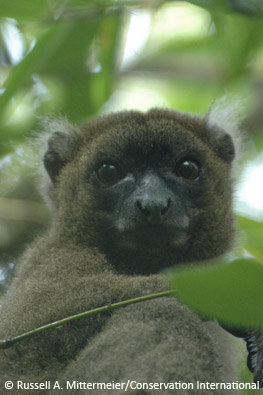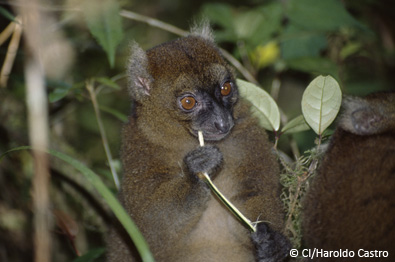The EDGE team recently heard some great news concerning EDGE mammal no 23 – the greater bamboo lemur. The largest of the bamboo lemurs, this species is also the rarest. The following report is from Conservation International:
Antananarivo, Madagascar – A scientific expedition into Madagascar’s rainforests has doubled the number of locations where the world’s rarest lemur, the Greater Bamboo Lemur (Prolemur simus), is known to occur.
Dr Russ Mittermeier, president of Conservation International and renowned lemur expert, hailed the discovery as “another milestone in saving one of the world’s most threatened primates”.
The Greater Bamboo Lemur – which, like China’s giant panda lives on a diet consisting almost exclusively of bamboo – was thought to be extinct until rediscovered in the early 1980s. It is the only species within the Prolemur genus, and current scientific knowledge indicates that it is the most endangered of all lemurs – with less than 100 thought to survive in the wild.
Occurring only in Madagascar, there is evidence to show it was once widely distributed across the island, but it is now restricted to a small part of the remaining eastern rainforest belt and a handful of outlying degraded forest fragments. The animals’ population has been declining for years due to rainforest destruction, over-exploitation of the Giant Bamboo it feeds on, hunting, and, potentially, climate change.
“When we first realised the extent of their decline it was clear that we had to respond, and fast”, revealed Tony King of The Aspinall Foundation’s bamboo lemur project. “These remarkable discoveries give us renewed hope for the challenge ahead of us”.
The survey was undertaken by The Aspinall Foundation, Conservation International, Association Mitsinjo and GERP. The team of researchers and local guides headed for remote areas of Madagascar’s Ankeniheny-Zahamena rainforest, soon to be officially declared the island nation’s latest protected area. They trekked several hundred miles in total, often off-road, on foot or in dug-out canoes, focussing their efforts on remaining stands of giant bamboo, searching for characteristic feeding remains, fresh droppings, or even a rare glimpse of the lemur itself, with its black face and orange eyes contrasting with its distinctive white ear tufts.
“We found evidence of Prolemur simus at eleven different sites throughout this 370,000 hectare forest”, Conservation International primatologist Tovonanahary Rasolofoharivelo explained. “The new localities lie in the southeastern and central parts of Ankeniheny-Zahamena”.
The team enjoyed tremendous support by local communities who will play a key role in the management and conservation of the new protected area. “If you want to succeed in finding an animal as rare and secretive as the Greater Bamboo Lemur, you have to work with the local communities who have an intimate knowledge of the forest they live in” states Rainer Dolch of Association Mitsinjo.
“This is an extraordinary success for our efforts to save the species,” said Dr Jonah Ratsimbazafy of the Malagasy Primate Group GERP. “It should put nature conservation back on the agenda in Madagascar, after recent lawlessness and a surge in illegal logging within national parks, which risked annihilating previous conservation successes”.
“Searching for the world’s rarest and most elusive lemur in this remote forest was a big gamble” added Damian Aspinall of The Aspinall Foundation, “but sometimes that’s what it takes to help save a species from the brink of extinction”.

